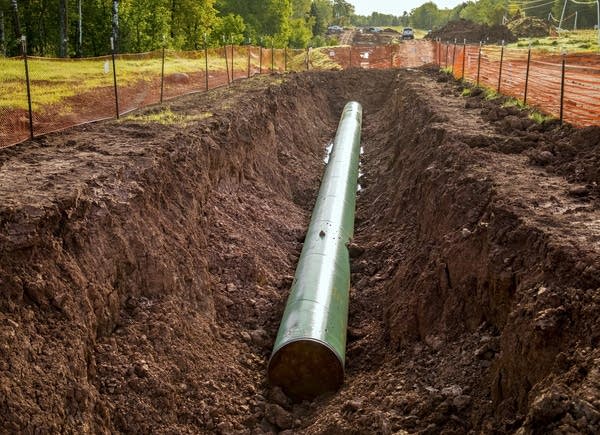Why no one agrees on Line 3 pipeline's climate change impact

Go Deeper.
Create an account or log in to save stories.
Like this?
Thanks for liking this story! We have added it to a list of your favorite stories.
Calculating the carbon footprint of a project like Enbridge Energy's proposed Line 3 oil pipeline is complicated. Not only are there multiple steps involved in the analysis, but there's also a need to make an educated guess about what the world would look like with and without the new pipeline.
With the Minnesota Public Utilities Commission set to decide Line 3's fate, there's a lot of disagreement over the educated guesses on its carbon footprint.
We attempt to break it down below (or click on the player above to hear an audio explainer).
Turn Up Your Support
MPR News helps you turn down the noise and build shared understanding. Turn up your support for this public resource and keep trusted journalism accessible to all.
What does Enbridge say about the climate change impact of its Line 3 proposal?
Enbridge argues that building a new Line 3 to replace the existing Line 3 crossing Minnesota would result in fewer greenhouse gas emissions than if it isn't built. The company says the new Line 3 would carry up to 760,000 barrels a day to meet demand for oil. If it isn't built, Enbridge argues that oil from Alberta's oil sands will still move to market and be used by us in cars, trucks, planes, etc. The existing Line 3 can only move 390,000 barrels per day, so additional oil would need to be moved by train or truck, which are both less efficient than pipelines. In addition, maintaining the old Line 3 would result in significant emissions because it's less efficient and would also require heavy equipment and integrity digs to ensure its safety. While Enbridge officials acknowledge that climate change exists, they argue building Line 3 would not worsen climate change.

What do environmentalists say about the climate change impact of the Line 3 proposal?
Environmental groups including 350.org, MN350, the Natural Resources Defense Council and others say Line 3 would enable up to 760,000 barrels of oil to be extracted and burned every year for 30 years, exacerbating climate change. Their goal is to oppose every pipeline coming out of Alberta's oil sands, because they say that without pipelines, companies can't feasibly move oil from such a remote area to the markets where it will be refined and burned. In the case of Line 3, environmentalists argue continuing to operate the existing Line 3 won't be a long-term solution for Enbridge, and therefore stopping the new Line 3 could keep oil in the ground and prevent additional greenhouse gas emissions.
Is there an independent analysis of Line 3's potential climate change impact?
Yes, although determining which scenario to use is still a judgment call. The environmental impact statement calculates the life-cycle emissions of the project. That includes extracting oil from the earth, transporting it in a pipeline, refining it into gasoline and diesel, transporting finished fuel to fuel stations, and combustion. If the oil flowing in the new Line 3 is treated as a new energy source, the EIS says the project would annually add 193 million tons of carbon dioxide (CO2) to the atmosphere — as much as a dozen of the country's largest coal-fired power plants emit in a year. If the new Line 3 carries oil that would move and be burned regardless of the pipeline's existence, the EIS says the project would annually add up to 35 million tons of CO2 to the atmosphere, or a maximum of the annual emissions of two big coal-fired power plants. The emissions would vary depending on the source of the oil.

Isn't heavy crude oil from Canada's oil sands more carbon-intensive than other sources of oil, such as light crude?
Yes. The EIS cites a Department of State study showing heavy crude from Canada can have very high life cycle greenhouse gas emissions. But there are a lot of details that determine the actual impact. There are different ways of extracting oil from the oil sands, for example. During the refining process, some refineries are more efficient than others. Flint Hills, which would receive some of the oil from the new Line 3, is constructing a combined heat and power plant in Rosemount, Minn., that will significantly reduce its energy use. But mitigation strategies like this can only go so far, because the last stage of the process — burning the finished gasoline or diesel — accounts for 70 to 80 percent of the overall emissions.
Does anyone know what the true impact of the Line 3 pipeline will be?
No, because it involves predicting what will happen in the future. The best the experts can do is use modeling to figure out what range of scenarios is most likely. For example, the Department of Commerce argues that demand for oil will go down, but Enbridge predicts it will be similar to what it is today for many years to come. These assumptions are based on predictions, like how many electric cars will replace cars with gas tanks in the future.
Sources: Revised Final Environmental Impact Statement for Line 3 and interviews with Enbridge, the National Resources Defense Council, Argonne National Laboratory engineer Amgad Elgowainy , University of Minnesota economist Stephen Polasky and consultant Stefan Unnasch of Life Cycle Associates.
Dear reader,
The trustworthy and factual news you find here at MPR News relies on the generosity of readers like you.
Your donation ensures that our journalism remains available to all, connecting communities and facilitating better conversations for everyone.
Will you make a gift today to help keep this trusted new source accessible to all?




